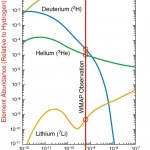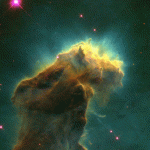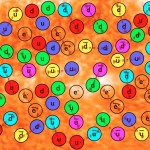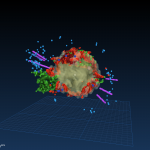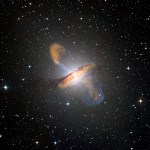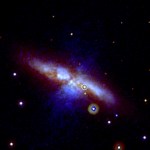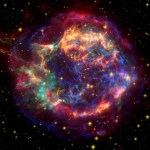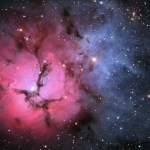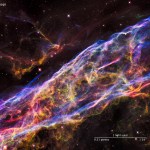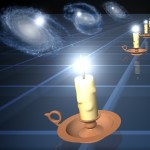Supernovae
"The discovery of deuterium and the marked differences in the physical and chemical properties of hydrogen and deuterium, together with an efficient method for the separation of these isotopes, have opened an interesting field of research in several of the major branches of science." -Harold Urey
By time the first few minutes of the Big Bang are over, the Universe has formed all the elements it’s ever going to form until the first stars are born. At that point, the Universe is made out of 75% hydrogen and 25% helium, with only tiny, trace amounts of other isotopes and elements like deuterium…
"There’s no difference between a pessimist who says, “Oh it’s hopeless, so don’t bother doing anything.” and an optimist who says, “Don’t bother doing anything, it’s going to turn out fine anyways.” Either way, nothing happens." -Yvon Chouinard
Are the beautiful and iconic Pillars of Creation, located deep within the Eagle Nebula, still around today? At a distant of 7,000 light years, the Pillars could have been destroyed at any point from about 5,000 B.C. to the present, and we’d have no way of knowing. When they were first imaged in 1995, many speculated that the nebula, containing new…
“It is the function of science to discover the existence of a general reign of order in nature and to find the causes governing this order. And this refers in equal measure to the relations of man - social and political - and to the entire universe as a whole.” -Dmitri Mendeleev
When the Big Bang first occurred, the Universe was filled with all the various particles and antiparticles making up the Standard Model, and perhaps still others yet to be discovered. But missing from the list were protons, neutrons, or any of the atomic nuclei key to the life-giving elements in our Universe today.…
"When a massive star explodes at the end of its life, the explosion dispenses different elements-helium, carbon, oxygen, iron, nickel-across the universe, scattering stardust. That stardust now makes up the planets, including ours." -Michelle Cuevas
Every once in a while, a new light appears somewhere in the night sky: the result of a massive star reaching the end of its life. From many millions of light years away, the brilliance of a supernova shines across the cosmos. Just a few days ago, a new light was discovered in a galaxy only 22 million light years away, making it the closest…
"The origin and evolution of life are connected in the most intimate way with the origin and evolution of the stars." -Carl Sagan
The Crab Nebula is one of the most interesting and compelling objects in the entire night sky. In the year 1054, a supernova went off in the constellation of Taurus, where it became brighter than anything other than the Sun and Moon in the sky. Some 700 years later, astronomers discovered the remnant of that supernova: the Crab Nebula.
An optical composite/mosaic of the Crab Nebula as taken with the Hubble Space Telescope. The different colors correspond to…
“Without these supernova explosions, there are no mist-covered swamps, computer chips, trilobites, Mozart or the tears of a little girl. Without exploding stars, perhaps there could be a heaven, but there is certainly no Earth.” -Clifford A. Pickover
One of the most sobering cosmic truths is that every star in the Universe will someday run out of fuel and die. Once its core fuel is exhausted, all it can do is contract under its own gravitational pull, fusing heavier and heavier elements until it can go no further. Only the most massive stars, capable of continuing to fuse carbon (and even…
"When a star goes supernova, the explosion emits enough light to overshadow an entire solar system, even a galaxy. Such explosions can set off the creation of new stars." -Todd Nelsen
In February of 1987, the first light from a supernova some 168,000 light years away was observed on Earth. It became the closest supernova to be observed since the invention of the telescope. As a result, it’s taught us more about massive star death, ejecta and supernova remnant evolution than any other object in the Universe.
The two loop-like structures, identified in this Hubble image from five years ago,…
"Even with all the collected data we cannot say with 100% certainty that the ASASSN-15lh event was a tidal disruption event. But it is by far the most likely explanation." -Giorgos Leloudas
Last year, a record-shattering event occurred: we saw the brightest supernova ever observed in the Universe. It outshone the previous record holder by more than double, and it reached a peak brightness of more than 20 times the sum total of all the stars in the Milky Way galaxy. Surprisingly, it occurred in a red, quiet galaxy, rather than the bright blue ones famous for them. After 10 months of follow-up…
"When we recall the past, we usually find that it is the simplest things - not the great occasions - that in retrospect give off the greatest glow of happiness." -Bob Hope
When a very massive star reaches the end of its life, it runs out of burnable fuel. As a result, the core collapses, heats up and undergoes a runaway fusion reaction. While many heavy elements are formed and a tremendous amount of energy is released, the very core implodes, tearing apart the outer layers of the star in a supernova explosion.
An animation sequence of the 17th century supernova in the constellation of…
"Even if I stumble on to the absolute truth of any aspect of the universe, I will not realise my luck and instead will spend my life trying to find flaws in this understanding - such is the role of a scientist." -Brian Schmidt
Just a few days ago, a new paper was published in the journal Scientific Reports claiming that the evidence for acceleration from Type Ia supernovae was much flimsier than anyone gave it credit for. Rather than living up to the 5-sigma standard for scientific discovery, the authors claimed that there was only marginal, 3-sigma evidence for any sort of acceleration…
"My eureka moment was in the dead of night, the early hours of the morning, on a cold, cold night, and my feet were so cold, they were aching. But when the result poured out of the charts, you just forget all that. You realize instantly how significant this is—what it is you’ve really landed on—and it’s great!" -Jocelyn Bell-Burnell, on the discovery of the first pulsar
Nearly 1,000 years ago, in 1054, a massive star in the constellation of Taurus, invisible at some 6,500 light years away, exploded in a type II supernova. Today, its remnant measures 10 light years across, while its inner core…
“When a star goes supernova, the explosion emits enough light to overshadow an entire solar system, even a galaxy. Such explosions can set off the creation of new stars. In its own way, it was not unlike being born.” -Todd Nelsen
The vast majority of elements beyond hydrogen found on Earth were created inside a massive star and blown back into the interstellar medium in a catastrophic supernova explosion. In a certain way, everything you've ever held in your hand -- including another person's hand -- is you holding a dead star.
The Cassiopeia A supernova remnant, as imaged in the visible…
“If I can't make it through one door, I'll go through another door - or I'll make a door. Something terrific will come no matter how dark the present.” -Rabindranath Tagore
Time continues marching on here at Starts With A Bang, just as it does everywhere. My Patreon supporters have stepped up their game, and we're just $21 shy of unlocking our next goal! There are two great new items this week I'd love to share with you: first, our newest Podcast on dark energy and the fate of the Universe,
and second, a video whose script I helped write (with a bonus coming up) for…
"It's everywhere, really. It's between the galaxies. It is in this room. We believe that everywhere that you have space, empty space, that you cannot avoid having some of this dark energy." -Adam Riess
Back in the 1990s, scientists were quite surprised to find that when they measured the brightness and redshifts of distant supernovae, they appeared fainter than one would expect, leading us to conclude that the Universe was expanding at an accelerating rate to push them farther away. But a 2015 study put forth a possibility that many scientists dreaded: that perhaps these distant supernovae…
“When a star goes supernova, the explosion emits enough light to overshadow an entire solar system, even a galaxy. Such explosions can set off the creation of new stars. In its own way, it was not unlike being born.” -Todd Nelson
In 1604, Kepler's supernova went off, the last Milky Way supernova visible to naked-eye skywatchers here on Earth. Yet since the development of radio and X-ray astronomy, other, more recent supernova remnants in our galaxy have been found. They've only been invisible to the naked eye because of the galactic gas and dust that blocks their visible light. In 1984/5, the…
"The two most common elements in the universe are hydrogen and stupidity." -Harlan Ellison
Shortly after the Big Bang, the Universe was filled with 99.99999993% hydrogen and helium, with the rest being lithium. But stars change everything, by fusing those elements -- the lightest ones -- into heavier ones, climbing the periodic table and enriching the Universe with its contents.
Image credit: NASA / JPL-Caltech.
After billions of years of star formation and nuclear fusion, a new 3rd most common element has emerged, and it isn’t carbon — formed from helium fusion — which only clocks in at…
"Truth is more valuable if it takes you a few years to find it." -Jules Renard
Of all the star-forming nebulae in our galaxy, the Trifid Nebula -- Messier 20 -- is thought to be the newest and youngest. Named "Trifid" for its threefold appearance, the blue reflection nebula, the red emission nebula, and the dark, star-forming dust lanes, it also bears a resemblance to the French tricolor flag.
Image credit: flickr user Marc Van Norden, via https://www.flickr.com/photos/mvannorden/8275065973/in/photostream/.
Because of the large number of young, hot stars still inside, the Trifid Nebula is…
“No matter how ‘normal’ people look, living ‘ordinary’ lives, everyone has a story to tell. And may be, just like you, everyone else is a misfit too.” -Sanhita Baruah
Every century or so, possibly even more frequently, a supernova goes off somewhere in the Milky Way galaxy. While the explosion itself is only visible for a few months, the remnant sticks around for many thousands of years. Although it isn't always visible in the portion of the spectrum our eyes are sensitive to, X-rays, Ultraviolet light, infrared and radio observations bring them to life.
Image credit: NASA/JPL-Caltech,…
“And no one showed us to the land
And no one knows the where’s or why’s
But something stirs and something tries
And starts to climb towards the light” -Pink Floyd, Echoes
It's pretty difficult to imagine, but a little over 300 years ago, a supernova -- a dying, ultramassive star -- exploded, giving rise to such a luminous explosion that it might have shone as bright as our entire galaxy.
And nobody on Earth saw it.
Image credit: NASA and The Hubble Heritage Team (STScI/AURA); Acknowledgment: R. Fesen (Dartmouth) and J. Morse (Univ. of Colorado).
Located in the plane of our Milky Way galaxy…
“Some say the world will end in fire,
Some say in ice.
From what I’ve tasted of desire
I hold with those who favor fire.
But if it had to perish twice,
I think I know enough of hate
To say that for destruction ice
Is also great
And would suffice.” -Robert Frost
We've come to believe that we know the fate of the Universe: that dark energy will drive distant galaxies and clusters apart, leaving only the objects that are already gravitationally bound together intact.
Image credit: NASA/JPL-Caltech.
Through the use of type Ia supernovae as standard candles, we've been able to trace out the…
